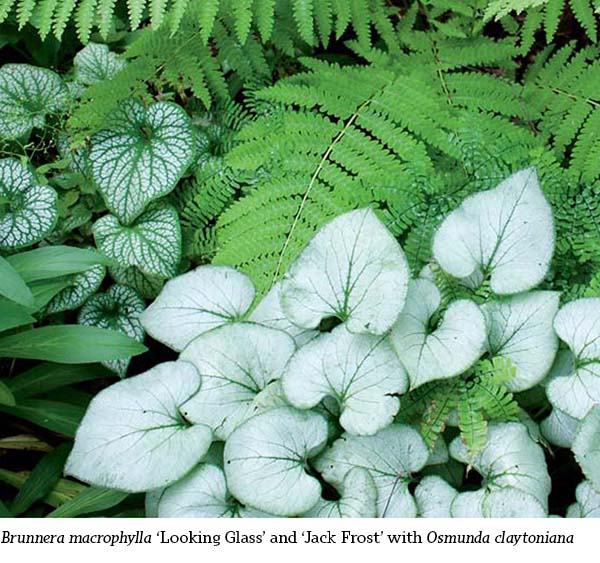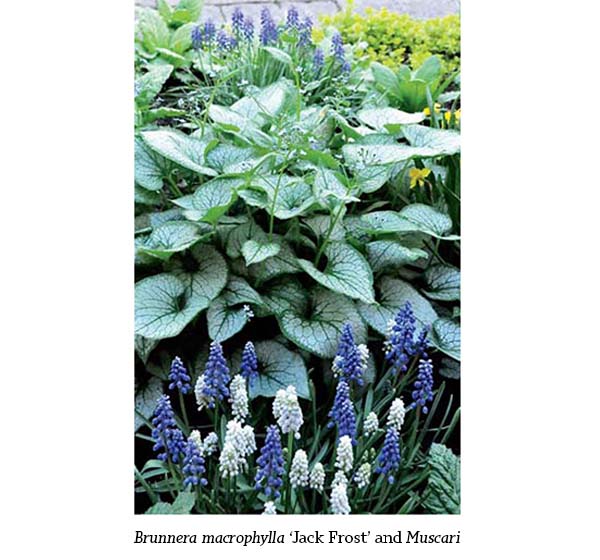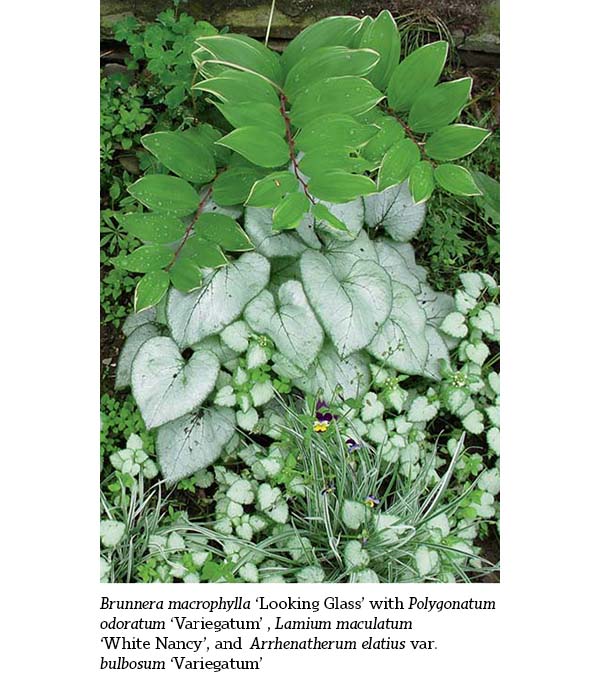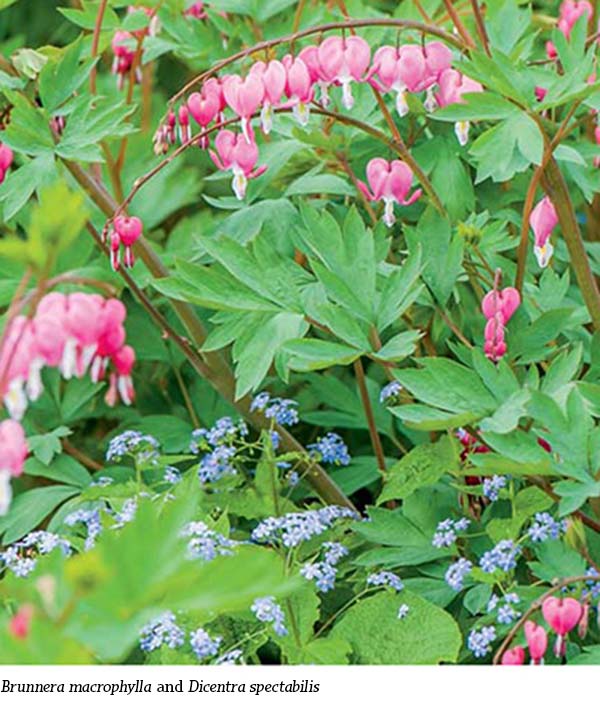
Brunnera
for flowers, form, and foliage
Siberian bugloss
Partial to full shade; average to moist but well-drained soil
Siberian bugloss (Brunnera macrophylla) is a beauty in bloom, but it’s even more valuable for its form and foliage, which extend its season of interest through the whole growing season. In spring, it sends up loose clusters of small but abundant flowers—usually sky blue, but sometimes blue-and-white or pure white—that reach a height of 12 to 18 inches. Then the 1-foot-tall mounds of heart-shaped leaves take over. They are commonly deep green, but there are a number of selections with silver markings or frosting, as well as some with variegated foliage. Siberian bugloss is best suited for Zones 3 to 7 or 8.
Color Considerations
In bloom, the sky blue flowers of Siberian bugloss are a perfect echo for blue forget-me-nots (Myosotis), and they’re exquisite mingling with other shades of blue to purple-blue, such as those in the blooms of Jacob’s ladders (Polemonium) or pulmonarias (Pulmonaria). Whites, pinks, and yellows are also charming with the blue flowers.
In leaf, solid green Siberian bugloss makes a great companion for any flowering or foliage partners, but it’s particularly handsome with white and pale blooms, like those of many astilbes (Astilbe) and columbines (Aquilegia). It’s also a top-notch co-star for vividly colored leaves, like those of bright yellow ‘Gold Heart’ bleeding heart (Dicentra spectabilis) and golden meadowsweet (Filipendula ulmaria ‘Aurea’); showy variegated foliage, like that of ‘Snow Cap’ broadleaf sedge (Carex siderosticha) and many hostas; and gray, blue, or silver leaves, like those of Japanese painted fern (Athyrium niponicum var. pictum) and pulmonarias.
Siberian bugloss cultivars with silver-and-green leaves, such as ‘Emerald Mist’ and ‘Langtrees’, look great in pairings with silvery, blue, or gray foliage. Selections that are mostly silver with just a touch of green, such as ‘Jack Frost’, pair perfectly with rich green companions to pick up their green veining or edging: Think of hellebores (Helleborus), for instance, or Robb’s spurge (Euphorbia amygdaloides var. robbiae) or wild gingers (Asarum). You could also use them to repeat other silvery perennials throughout a border. Or create eye-catching combinations with deep purple- to black-leaved partners: ‘Black Scallop’ common ajuga (Ajuga reptans), ‘Chocoholic’ bugbane (Cimicifuga), and black mondo grass (Ophiopogon planiscapus ‘Nigrescens’), for instance. For a really striking grouping, try a silvery Siberian bugloss with a red- or pink-leaved heuchera, such as ‘Berry Smoothie’ or ‘Fire Alarm’, and a red-flowered bleeding heart, such as ‘Bacchanal’.
A Perfect Match
With so many eye-catching silvery cultivars of Siberian bugloss to choose from, it’s easy to overlook the beauty of the ordinary green-leaved species. Instead of discarding the solid green seedlings I find from the fancier hybrids, I like to move them into gaps between equally sturdy but showier shade lovers, such as ‘Painter’s Palette’ jumpseed (Persicaria virginiana var. filiformis) and variegated Solomon’s seal (Polygonatum odoratum).
Shapes and Textures
Siberian bugloss plants form dense mounds of large, broad leaves that are ideal for repeating the bold forms of hostas, heucheras (Heuchera), and ligularias (Ligularia). For variety, pair them with upright companions, such as variegated Solomon’s seal (Polygonatum odoratum ‘Variegatum’) or toad lilies (Tricyrtis), and fill in around them with lower, carpeting partners, such as epimediums (Epimedium) or spotted deadnettle (Lamium maculatum). You can make dramatic contrasts by using them with other shade lovers that have jagged leaves, such as Allegheny pachysandra (Pachysandra procumbens) and goatsbeards (Aruncus); strappy to spiky leaves, like those of golden Hakone grass (Hakonechloa macra ‘Aureola’) or spiderworts (Tradescantia); or finely cut foliage, like that of ferns and bleeding hearts (Dicentra).
Seasonal Features
In the warmer parts of its range, Siberian bugloss begins blooming in early spring; farther north, it starts in mid-spring. The 3- to 4-week flowering period coincides with that of many other early-flowering perennials and with lots of spring bulbs, too, including daffodils and tulips. When the flowers finish, it’s a good idea to cut off the bloom stalks close to the base of the plant: Otherwise, the plants are likely to produce lots of seedlings, which won’t have the same markings as the parent. The foliage usually looks good through the rest of summer and fall, and it can linger well into winter in mild areas.
Bloom Buddies
Marvelous Matches for Flowering Combos
Siberian bugloss (Brunnera macrophylla) flowers most freely and looks most lush in partial shade with fertile, evenly moist soil: the same conditions that favor many other spring-flowering shade-garden favorites, including the sampling listed below.
Ajugas (Ajuga)
Bleeding hearts (Dicentra)
Columbines (Aquilegia)
Cowslip (Primula veris)
Creeping phlox (Phlox stolonifera)
Foamflowers (Tiarella)
Foamy bells (× Heucherella)
Jacob’s ladders (Polemonium)
Lady’s mantle (Alchemilla mollis)
Leopard’s banes (Doronicum)
Solomon’s plume (Smilacina racemosa)
Solomon’s seals (Polygonatum)
Spotted deadnettle (Lamium maculatum)
Wild geranium (Geranium maculatum)
Woodland phlox (Phlox divaricata)



